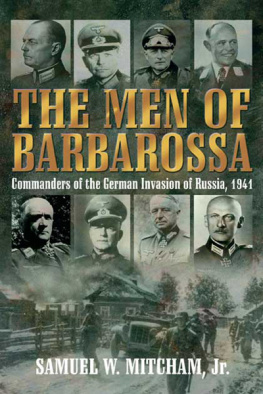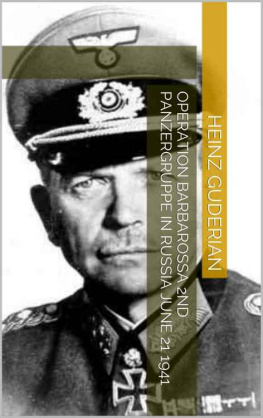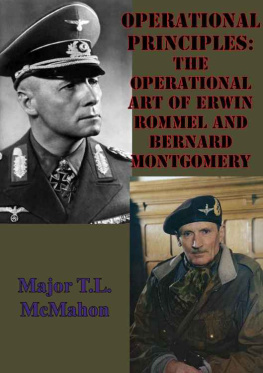
This edition is published by PICKLE PARTNERS PUBLISHINGwww.picklepartnerspublishing.com
To join our mailing list for new titles or for issues with our books picklepublishing@gmail.com
Or on Facebook
Text originally published in 1994 under the same title.
Pickle Partners Publishing 2014, all rights reserved. No part of this publication may be reproduced, stored in a retrieval system or transmitted by any means, electrical, mechanical or otherwise without the written permission of the copyright holder.
Publishers Note
Although in most cases we have retained the Authors original spelling and grammar to authentically reproduce the work of the Author and the original intent of such material, some additional notes and clarifications have been added for the modern readers benefit.
We have also made every effort to include all maps and illustrations of the original edition the limitations of formatting do not allow of including larger maps, we will upload as many of these maps as possible.
BARBAROSSA: PLANNING FOR OPERATIONAL FAILURE
by
Lieutenant Commander, John D. Snively United States Navy
TABLE OF CONTENTS
Contents
TABLE OF CONTENTS
REQUEST FROM THE PUBLISHER
ABSTRACT
The German planning process for the 1941 invasion of Soviet Russia is analyzed through the presentation of the major plans developed from July 1940 until June 1941. The final plan is then critiqued within the context of the applicable Principles of War. The planning process was characterized by significant disagreements between Hitler, the German High Command and the Army High Command. The major points of contention relate to the selection of primary objectives and force deployment patterns. A set of conclusions is presented which argues that the planning process was faulty due to a number of assumptions which were generally held by the officers who were involved in the process.
PREFACE
It is essential for students of operational art to examine the planning process of Operation Barbarossa. The lessons involved have not lost their relevancy through the years. Although the literature varies on why the Germans failed to achieve their goals, there is a general consensus regarding the incorrect assumptions held by the planners as they progressed through the process.
The reader should be aware that not all of the Principles of War are discussed during the critique portion of the study. Only the most relevant principles are discussed in order to provide proper analysis. The campaign planners utilized a number of these principles to their benefit, and others they chose to ignore (or so it seems).
It should also be pointed out that scholars disagree on the exact personal interactions which took place during the planning and execution phases of the campaign. It is at times difficult to ascertain how much influence a particular actor had upon Hitler during the process. There is also disagreement on the motives which resulted in Hitler deciding to carry out the invasion. Explanations include racism and economic motivations. Whatever the reasons were, the decision to invade Soviet Russia in 1941, initiated a sequence of events which finally resulted in the destruction of the Third Reich.
BARBAROSSA: PLANNING FOR OPERATIONAL FAILURE
CHAPTER I INTRODUCTION
The 1941 German Invasion of the Soviet Union was a military undertaking of immense proportions. Perhaps the greatest assembly of men, machines and supplies for a singular purpose that the world had ever seen. The elaborate and detailed planning process, which was required for such a massive operation, was characterized by both intense military and diplomatic maneuvers.
While there can be no question that Hitler was aware of the historical dangers of involving Germany in a two front war, his confidence of certain victory against the Soviets is well documented: We have only to kick in the front door, he once exclaimed, and the whole rotten Russian edifice will come tumbling down! {1} Hitlers confidence was based upon a number of observations and perceptions. The German army had experienced spectacular successes against Poland and France. Blitzkrieg warfare had proven to be effective in each instance, and there was no reason to doubt that an offensive against Soviet Russia would not yield the same results.
In addition, Hitler took into account the purges of the Soviet military leadership during the late 1930s, and the poor performance of Russian troops during their war with Finland from 1939-1940. These factors, when combined with the exceedingly poor German net assessment of Soviet strength and fighting capability, led Hitler to believe that success could most certainly be accomplished in a short time. It was under these perceived circumstances, that Hitler directed the planning for the invasion of Soviet Russia in the summer of 1940.
The purpose of this study is to examine the planning phases of Operation Barbarossa from July 1940 until the campaign was begun in June 1941. The planning process will then be analyzed within the framework of a number of the Principles of War. A set of conclusions will then be presented which will emphasize the reasons for the failure of the planning process.
In a general sense, it can be maintained that the failure of this campaign was the result of the misapplication of operational art during the planning phase, and later during the execution phase of the campaign. Barbarossa is also the story of conflict, disagreement and struggles for power inside the military leadership circles of the Third Reich. It is important to understand that the option to Invade Soviet Russia was not the only one available to Hitler during 1940. The strategic background, and a brief discussion of these options shall first be presented.
CHAPTER II
HITLERS STRATEGIC CHOICES
By the summer of 1940, Nazi Germany was clearly in a dominant position vis--vis the European continent. Hitler and his military had enjoyed overwhelming victory in every conflict: No conqueror since Napoleon had enjoyed similar hegemony in Europe {2} Despite the successes however, Hitler had been unable to force Great Britain to capitulate. Although all three German services had been deeply involved in the planning for the land invasion of Great Britain (codenamed SEALION), Hitler had lost interest in the actual execution of this plan by December of 1940. While scholars differ on Hitlers reasoning for this decision, there is no question that his attention was turning toward Soviet Russia as early as the summer of 1940.
During July of 1940, Hitler informed his generals of his intentions regarding the Soviets. According to General Halders war diary of 22 July 1940, Hitlers intention was: ...the defeat of the Russian Army, or the capture of at least as much Russian territory as necessary to prevent enemy attacks against Berlin and the Silesian industrial areas. {3} At that point in time however, and taking into account the strategic situation, an Invasion of Soviet Russia was not the only option available to the Fhrer.
A strategic alternative was presented to Hitler by Grand Admiral Erich Raeder in September of 1940. Raeder was concerned that Britain, supported by America and the Free French, would attack Italy from positions in North Africa. Germanys top priority therefore should be the sealing of the Mediterranean. This could be accomplished by the seizure of Gibraltar and Suez, a relatively simple operation. In order to accomplish this however, Hitler needed the cooperation of the Spanish dictator General Francisco Franco. Despite face to face meetings and the offer of territory in exchange for Spanish assistance, Franco refused to cooperate with Hitler. {4}










